What exactly is Google Analytics? How do statistics help website owners boost their online website? How does it all work?
Google Analytics is a free statistics tracker that can be used to find out:
- How visitors find your site.
- How visitors interact with your site.
- How your business is performing (see the health of your eCommerce and lead conversions).
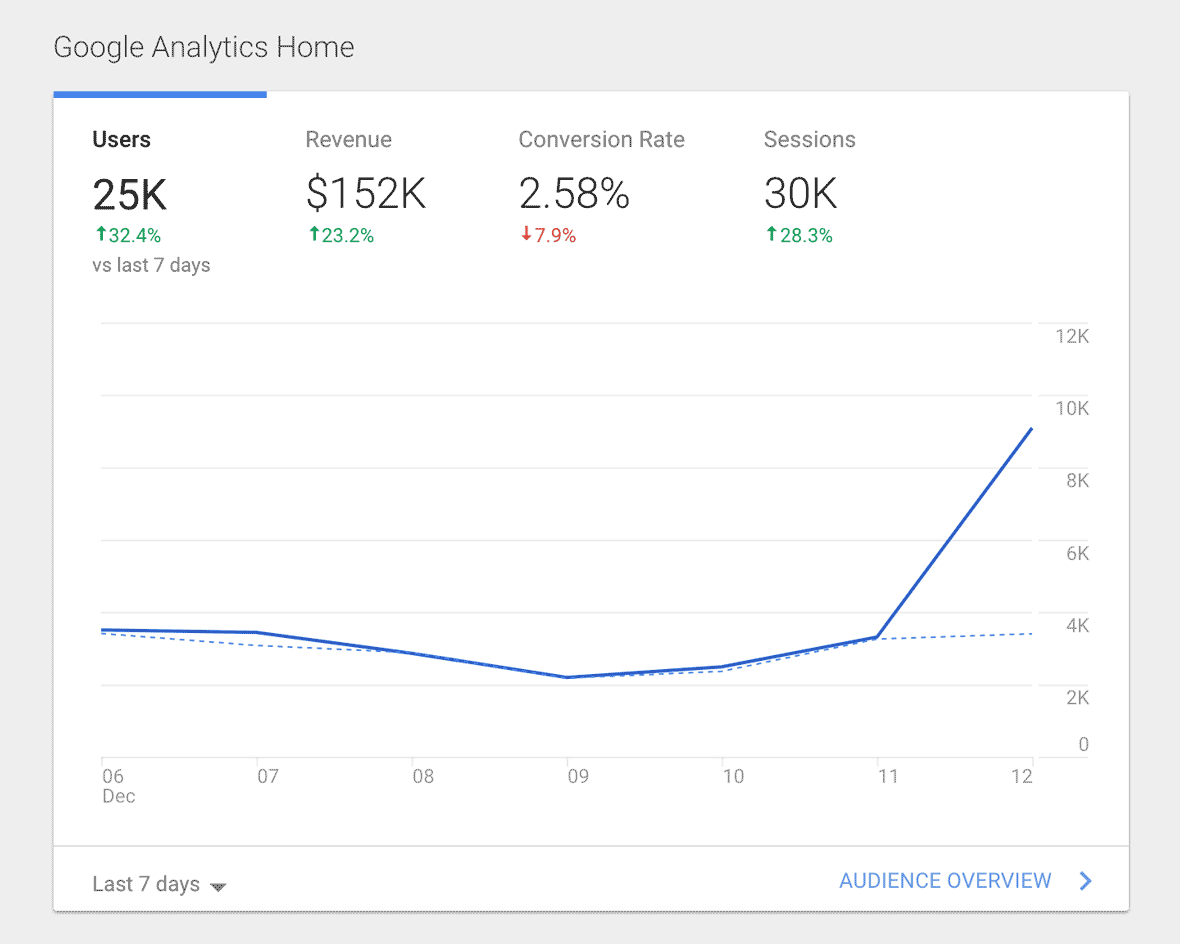
In this overview, we’ll focus on the essential areas of Google Analytics:
- Introduction to Google Analytics Reports
- Introduction to Google Analytics Explore
- Introduction to Google Analytics Advertising
- Manage your Google Analytics
Introduction to Google Analytics Reports
In a Google Analytics property, you’ll find the following reports:
- Reports snapshot
- Realtime
- Acquisition
- Engagement
- Monetization
- Retention
- User Attributes
- Tech
Below we’ll briefly go over each report. You’ll notice some of the detailed reports can be further customized. To learn more, please see Google’s guide here: Customize detail reports.
In the Reports snapshot, you will see an overall view of these reports, organized in cards with links for more details on the data.
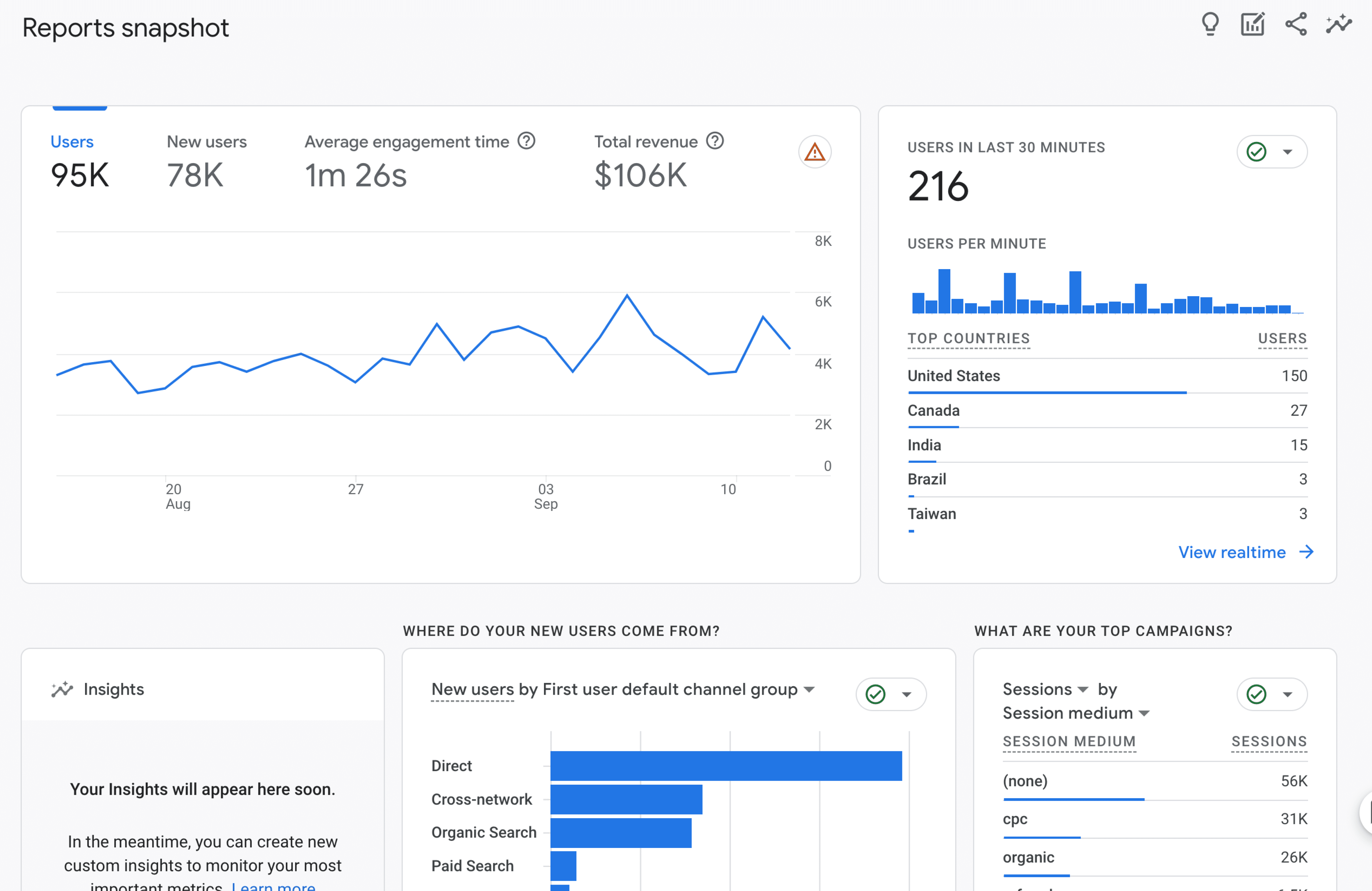
The Realtime report provides user activity within a 30-minute window and a variety of cards. In each card, you’ll be able to see a quick overview data of users by source, users by audience and etc (as indicated in each card) in real-time. You’ll also be able to interact with the cards to view more data.
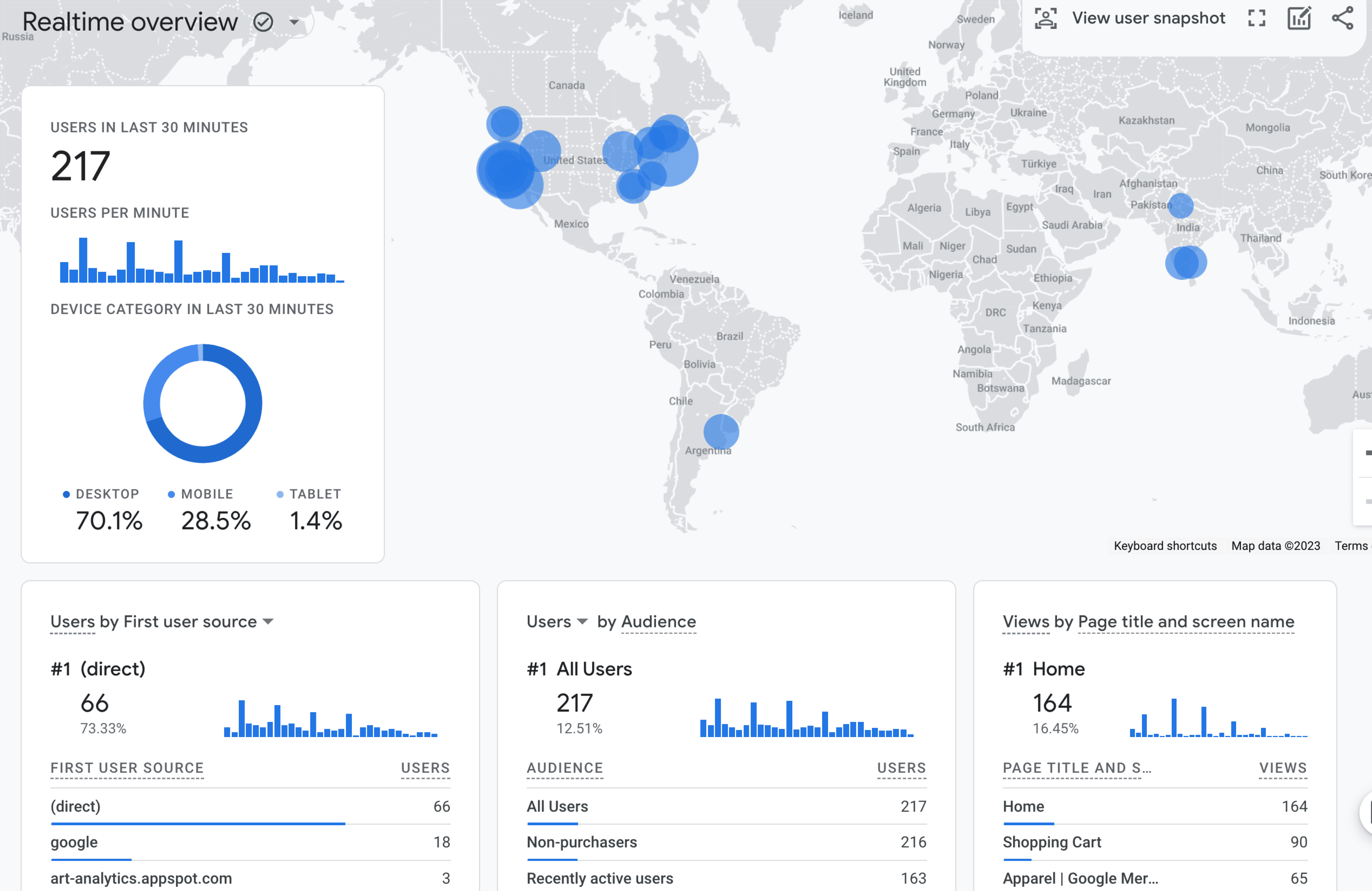
Within the Acquisition tab, the following reports are:
- Acquisition overview
- User acquisition
- Traffic acquisition
In the Acquisition overview report, you will see a general overview of how users find your website as well as Lifetime value. You’ll also see a mini real-time card and a Google Ad campaign performance card.
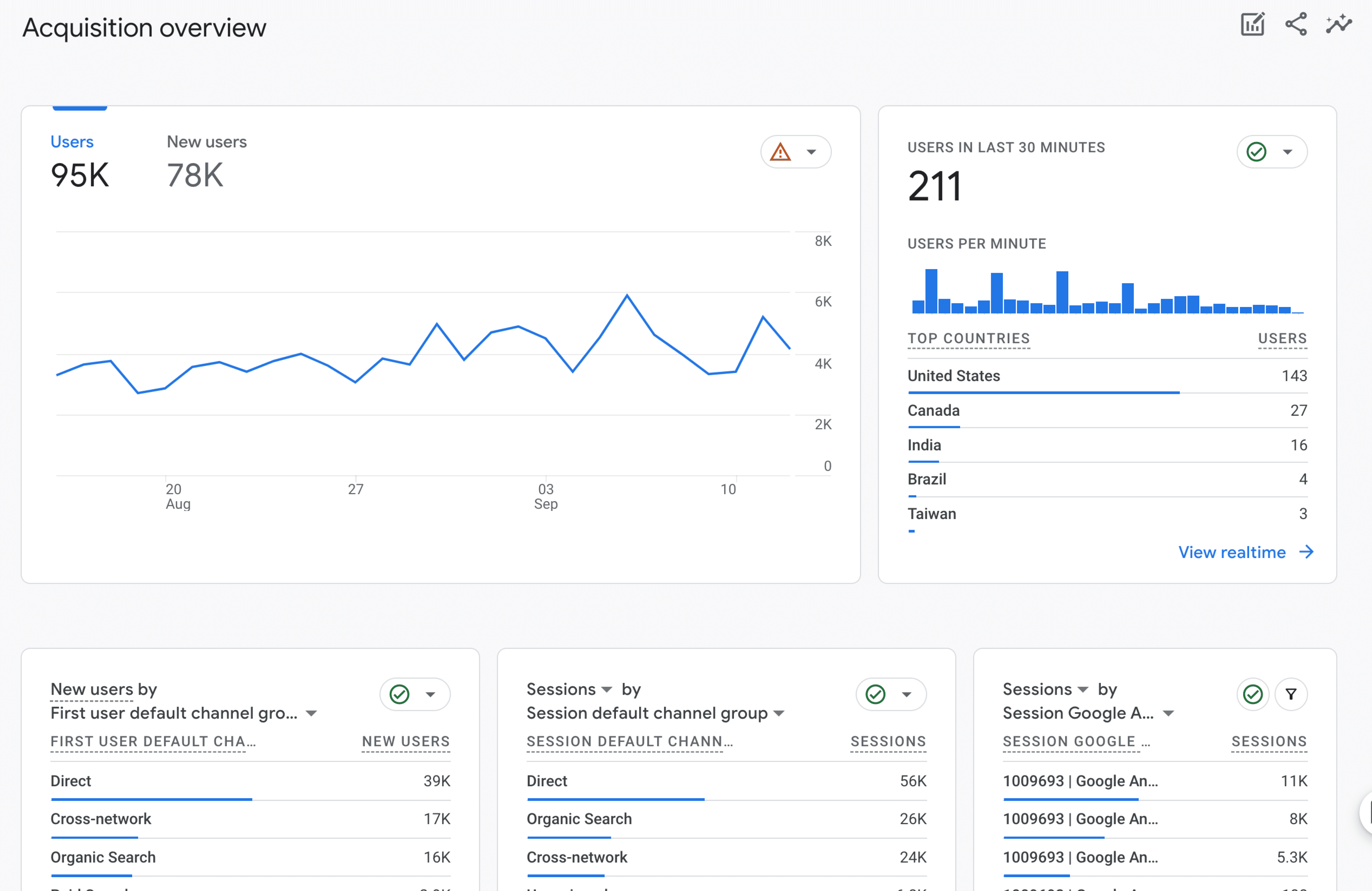
The User acquisition report provides a more detailed breakdown of new users and their source (not returning visitors).
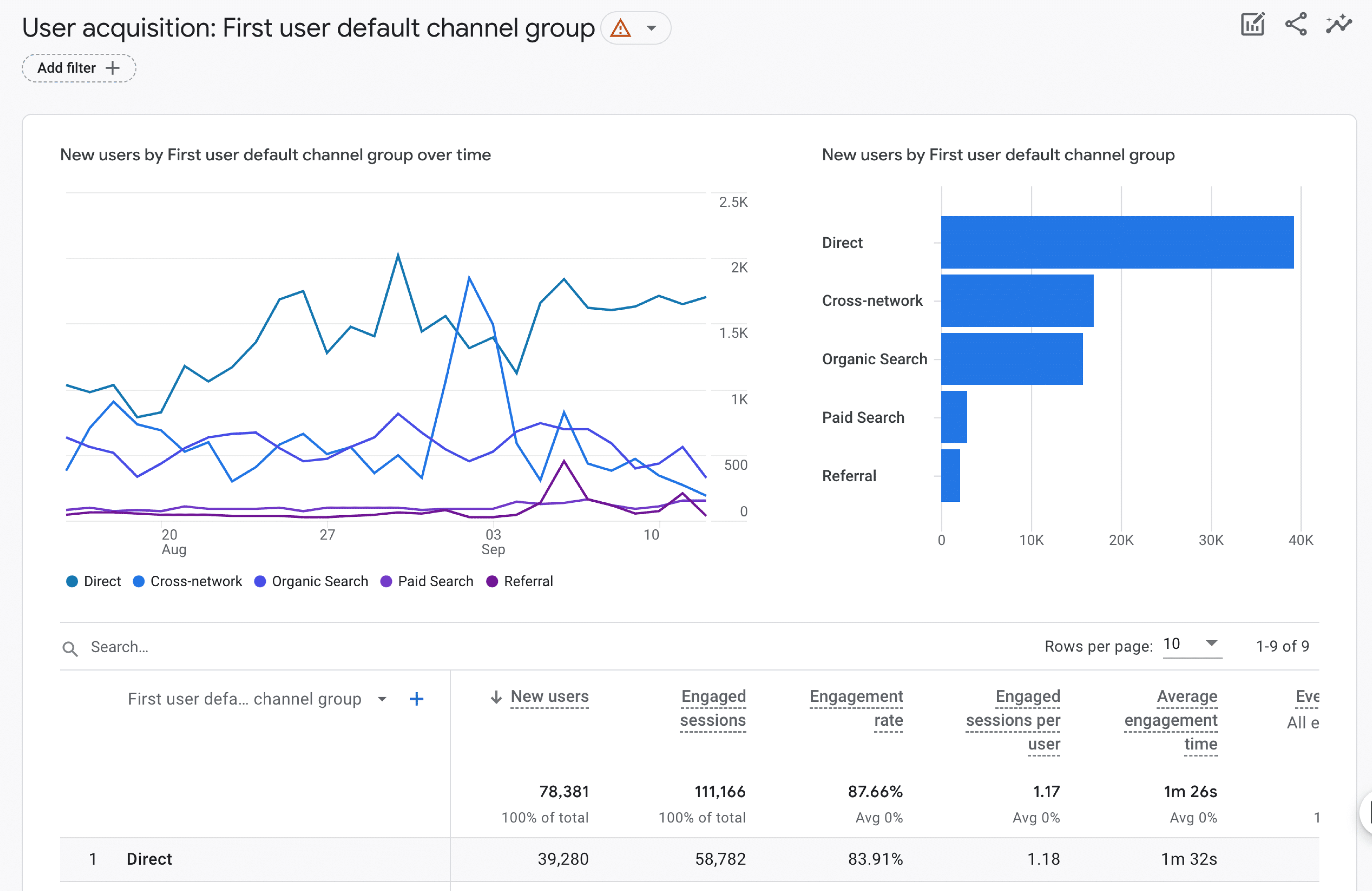
And the Traffic acquisition report displays a detailed breakdown of the Source/Medium of your site visitors.
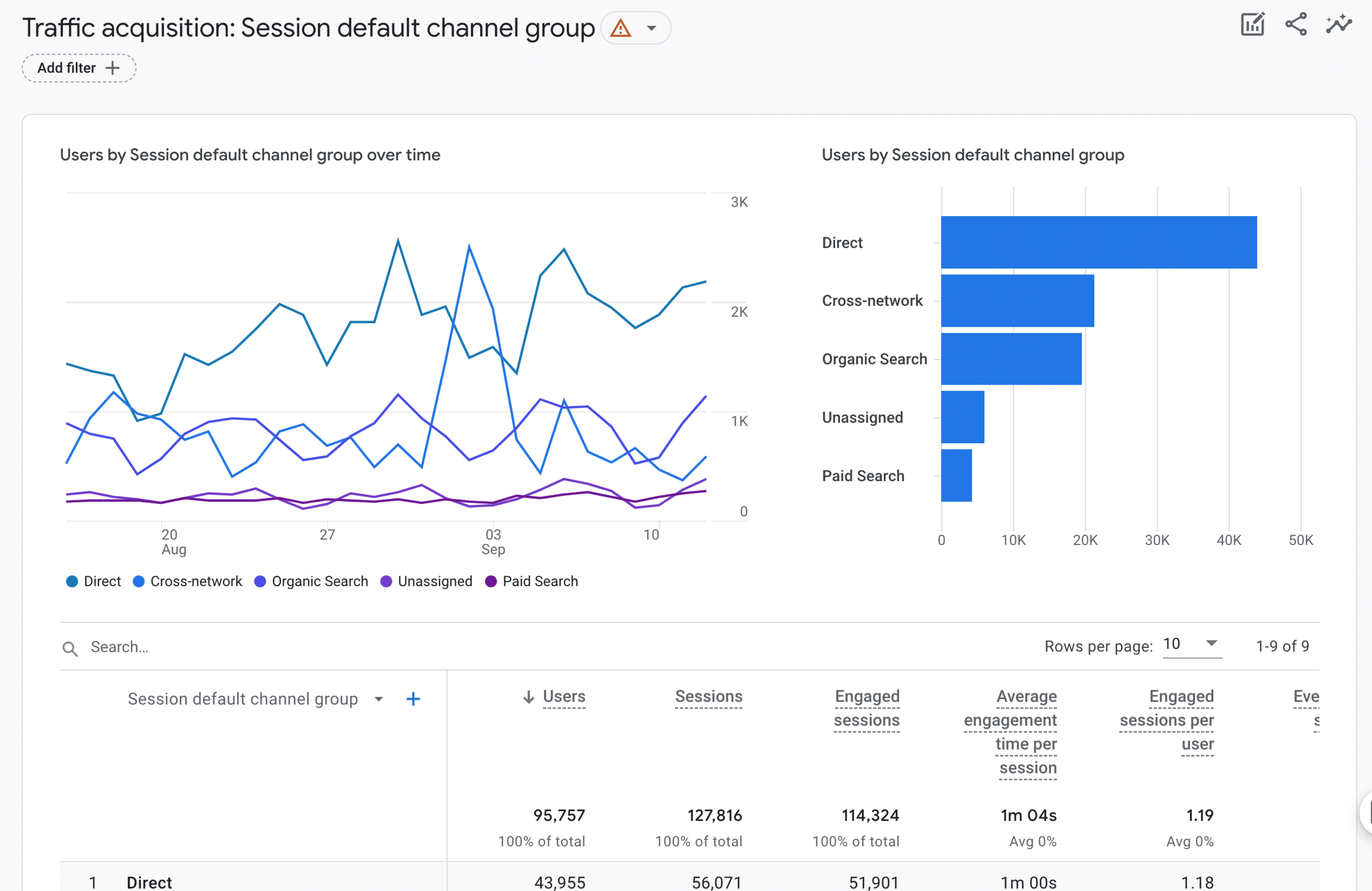
Within the Engagement tab, the following reports are:
- Engagement overview
- Events
- Conversions
- Pages and screens
- Landing Page
In the Engagement overview report, you will see a general overview of user engagement on your website as well a daily vs monthly ratio of your user activity (User stickiness).
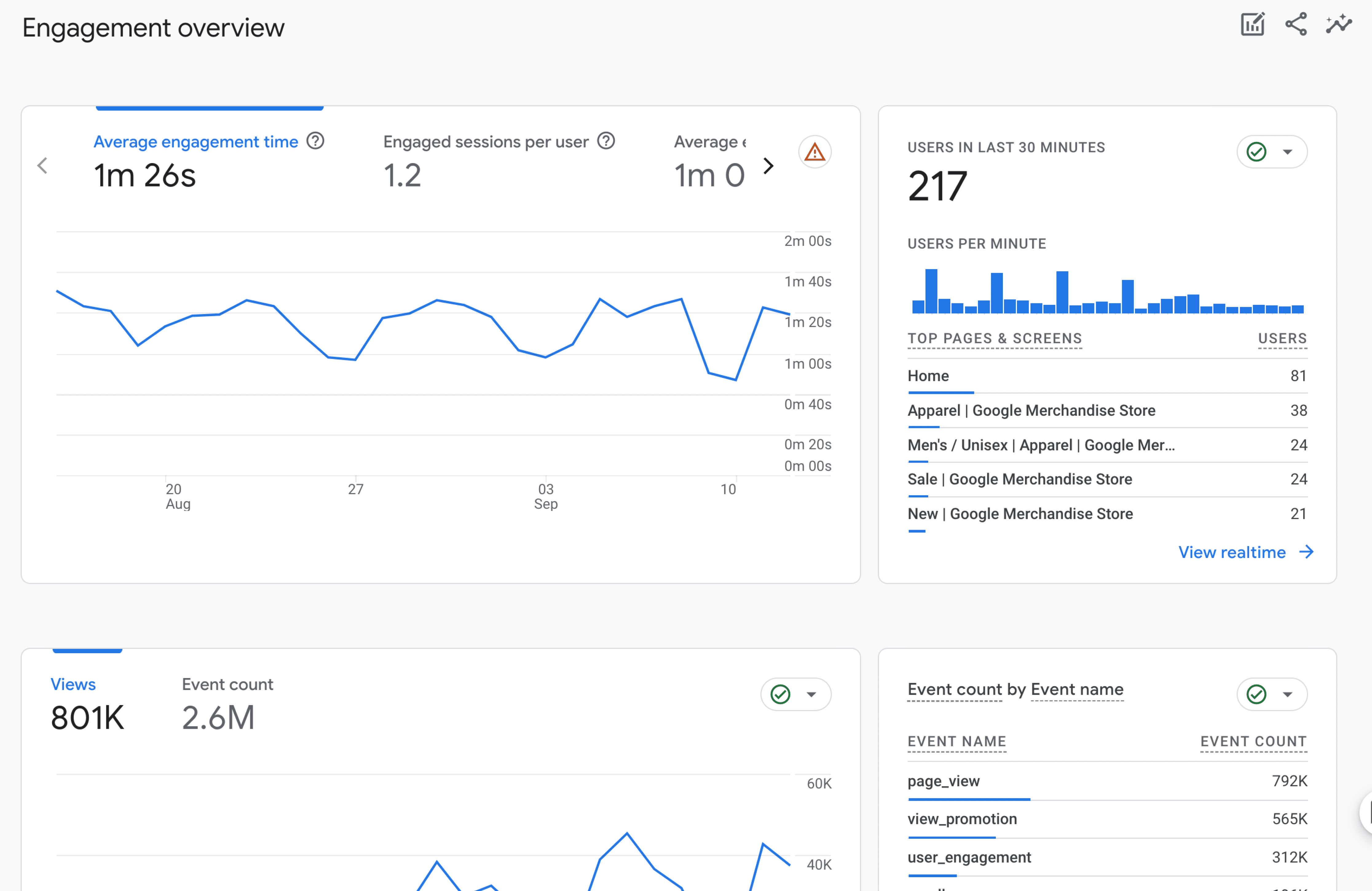
In the Events report, you will find an overview of all events such as page_view, session_start, as well as all custom events that ExactMetrics tracks for you.

You can click into each event to see a detailed report for each event. For example, to check your form impressions for a particular form on your website, click into forms_impression and locate the card Form ID.
If you prefer to see more granular data or to have more control over the data you would like to view, you’ll be able to create a custom report, known as a custom exploration, which we will cover in the next section (or, if you prefer, click here to jump to the Explore section).
In the Conversions report, similarly to the Events report, you will see events as well, but these events have been specifically marked as conversion.

In the Pages and screens report, you will be able to see views, user count, average time on page, and conversions of your WordPress pages.
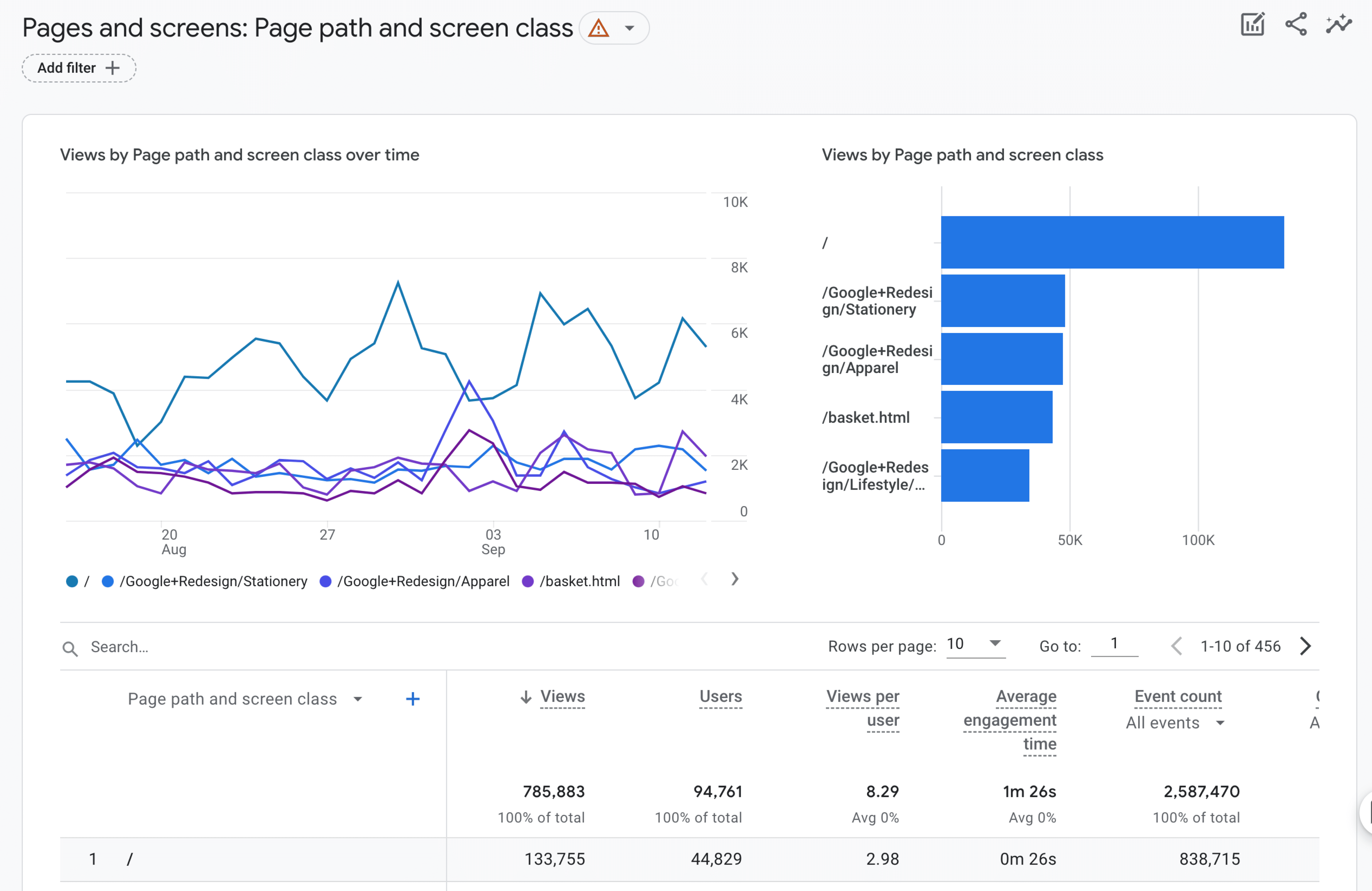
In the Landing page report, you’ll get a detailed view on which pages were tracked as the first page view during a site visitor’s session. If you see (not set), then it means that session is missing a page view event.

Within the Monetization tab, the following reports are:
- Overview
- Ecommerce purchases
- User purchase journey
- In-app purchases
- Publisher ads
- Promotions
In the Monetization overview report, you will see a general overview of your total revenue, ad revenue, number of purchasers, as well as cards for eCommerce purchases by item name, item list name, promotion name, and revenue by coupon and product ID.
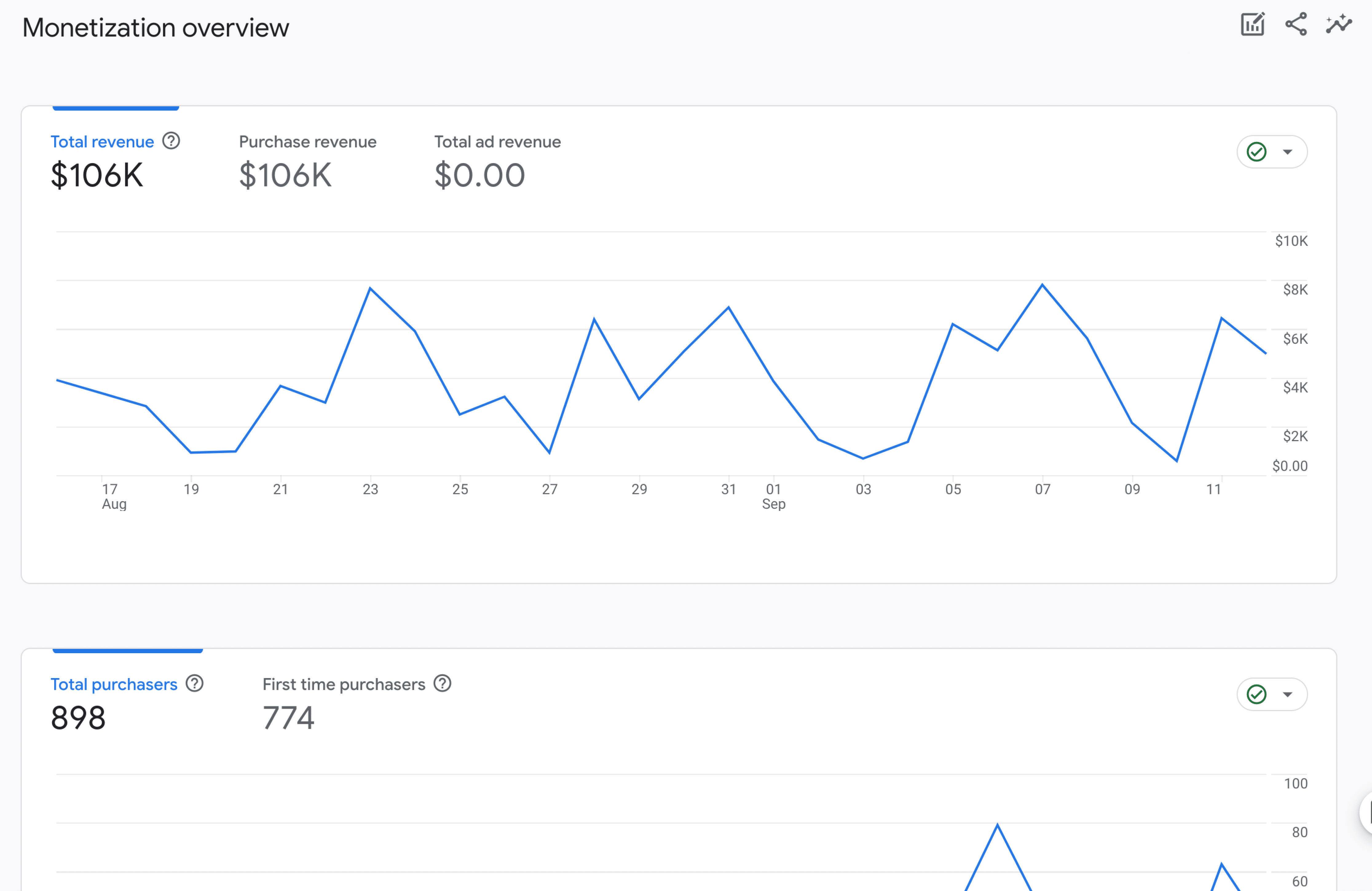
In the Ecommerce purchases report, you will see a more detailed breakdown of your product performance, with metrics such as views, add-to-carts, cart-to-view rate, eCommerce purchases, purchase-to-view rate, item purchase quantity, and item revenue.
For all mobile streams (iOS app or Android app streams), in the In-app purchases report you will see revenue grouped by product ID, and in the Publisher ads report you will see revenue from ads grouped by ad unit relating to your mobile app.
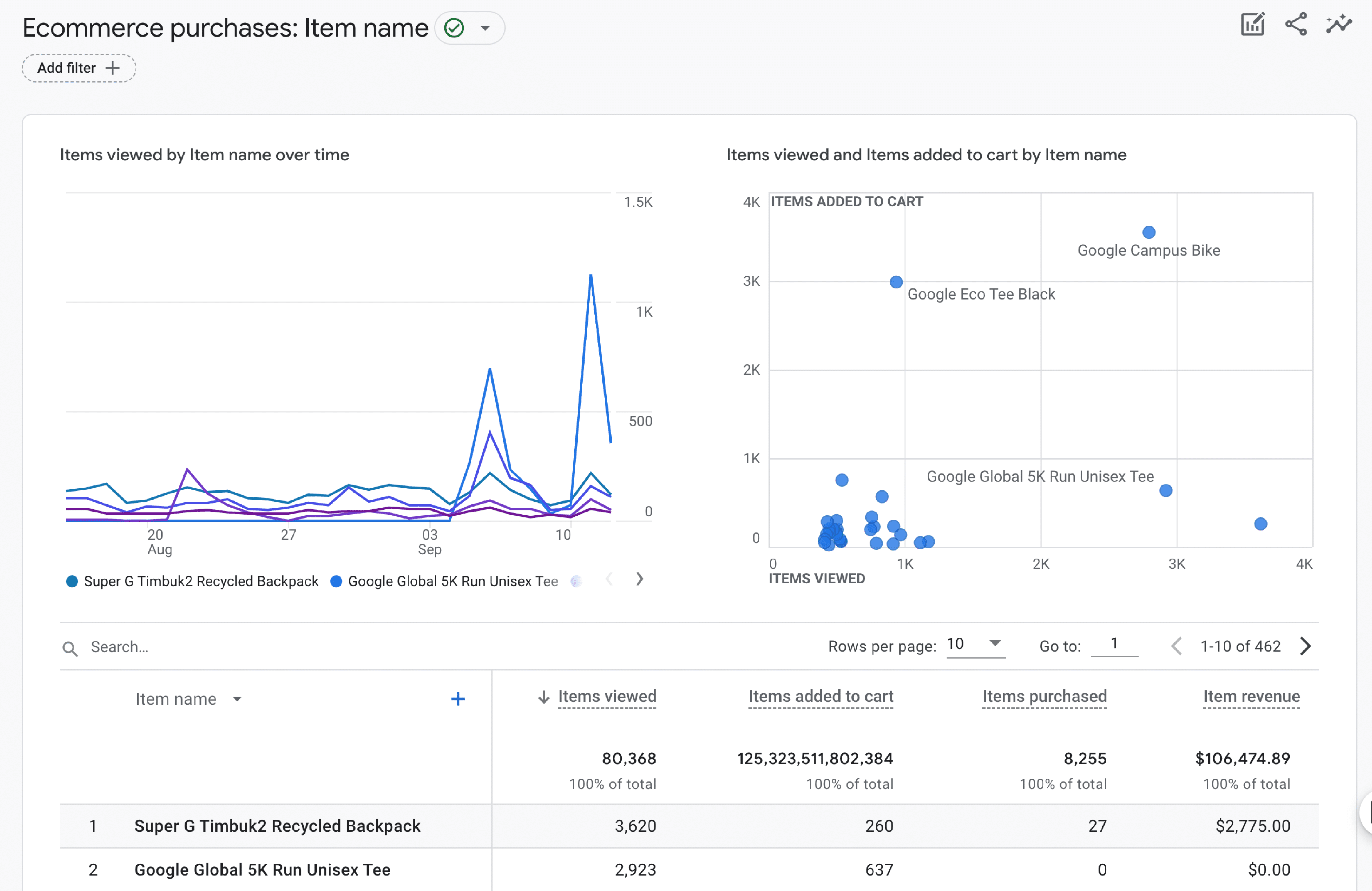
In the User purchase journey report, you’ll be able to see where you can make optimizations for better conversions, by observing where users are dropping off within your purchase funnel.
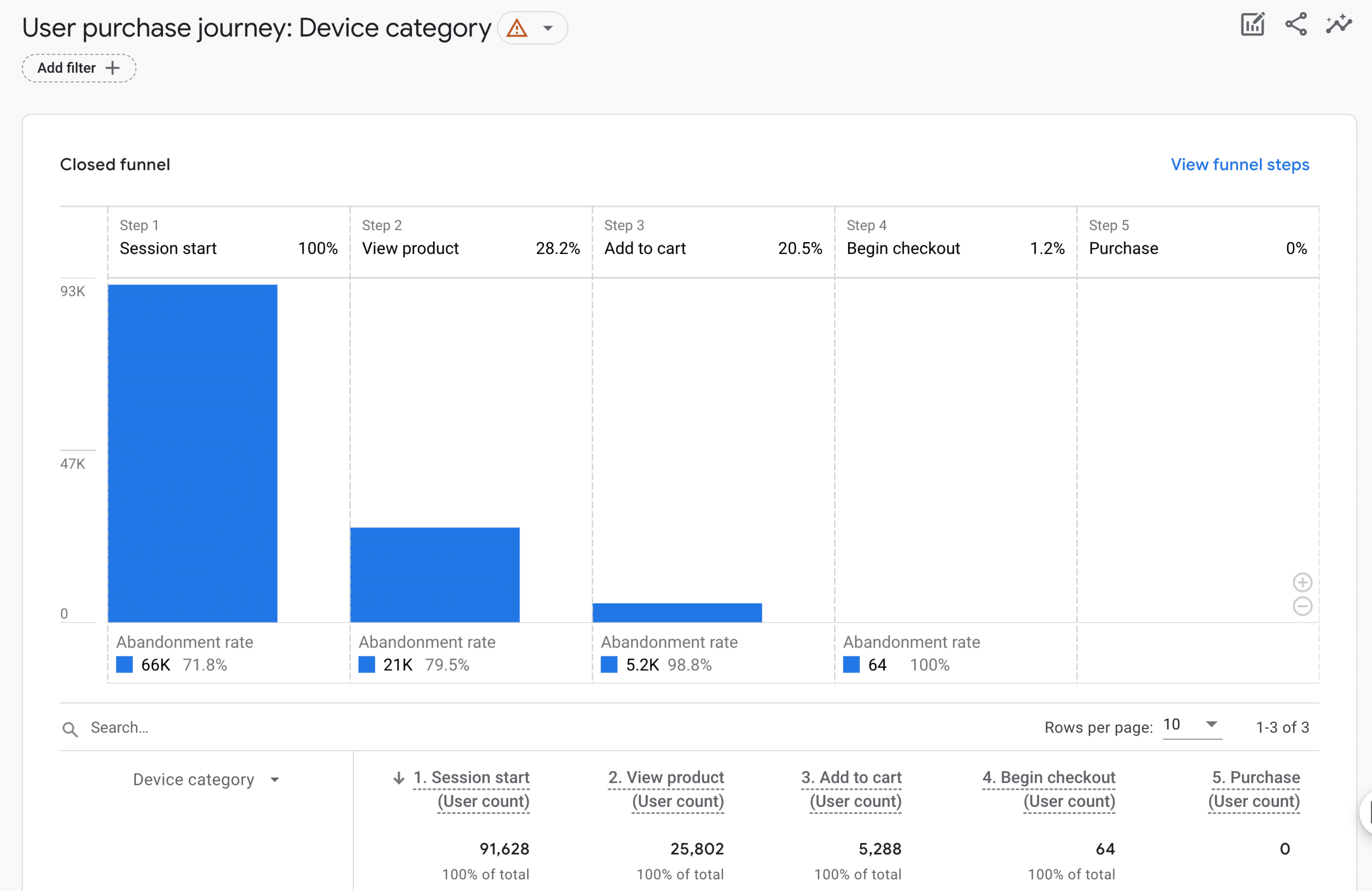
In the Promotions report, you can view how well your promotions are impacting your overall revenue.

In the Retention report, you will be able to view data on retention and engagement of new vs returning visitors.
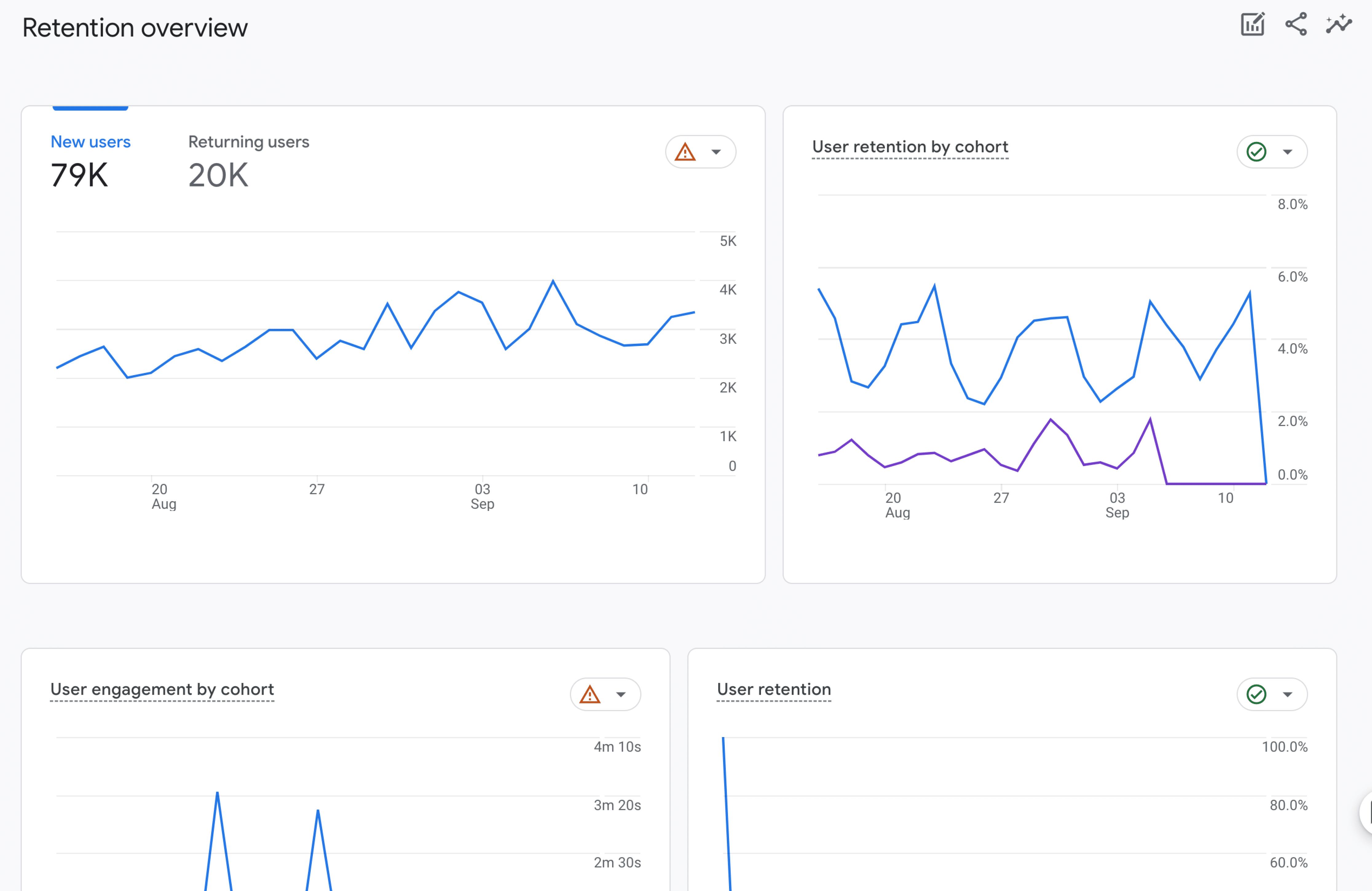
Within the Demographics tab, the following reports are:
- Overview
- Demographic details
- Audience
In the User attributes overview report, you will see a general overview of your users’ demographics, organized in cards with data on city, gender, interests, age, and language.
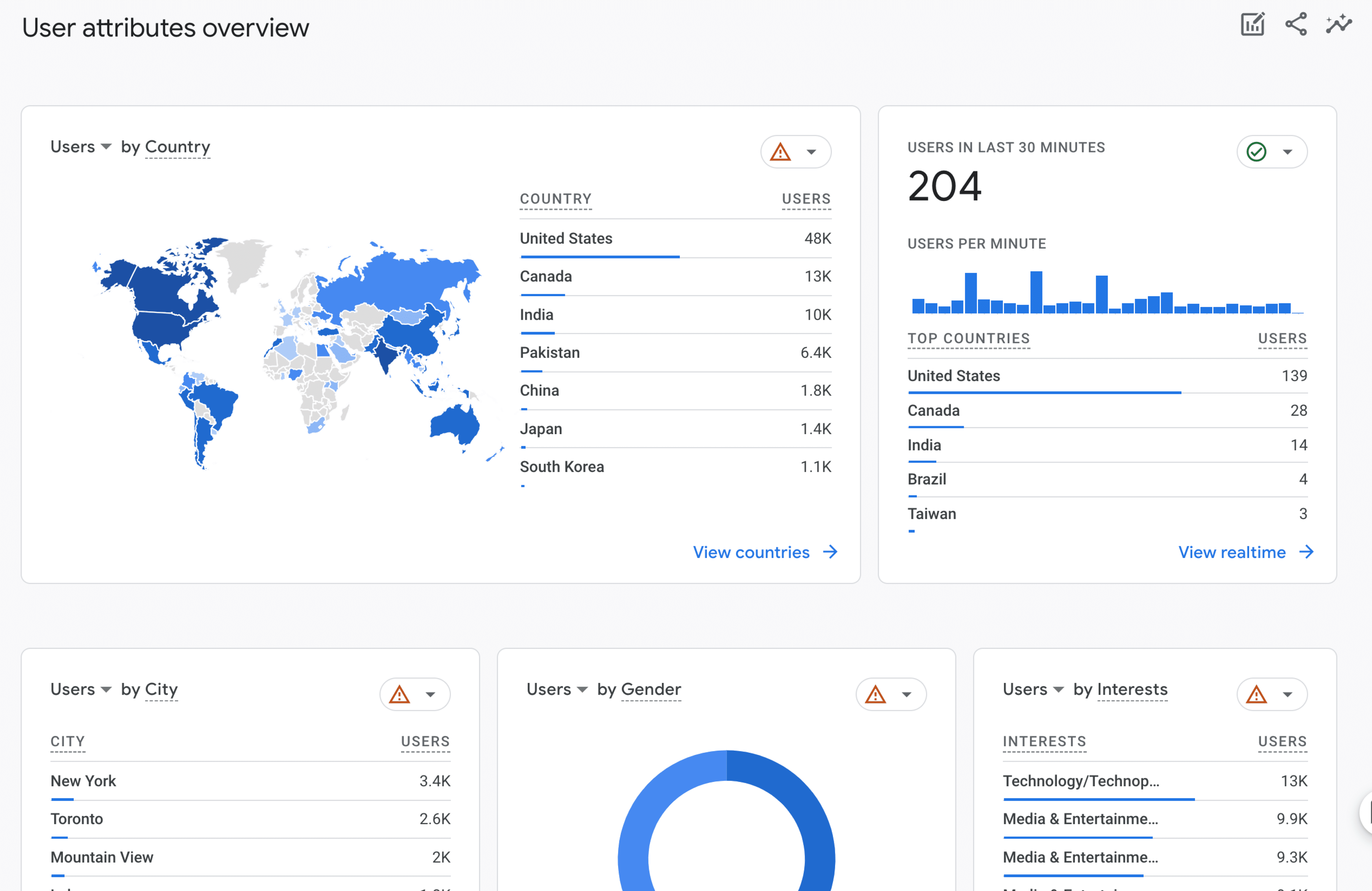
In the Demographic details report you will see a more detailed breakdown of your user demographics. By default, the report will load Country data, but this can be swapped by clicking on the “Country” parameter (under the “Search…” bar) and choosing other demographic options available in the dropdown.
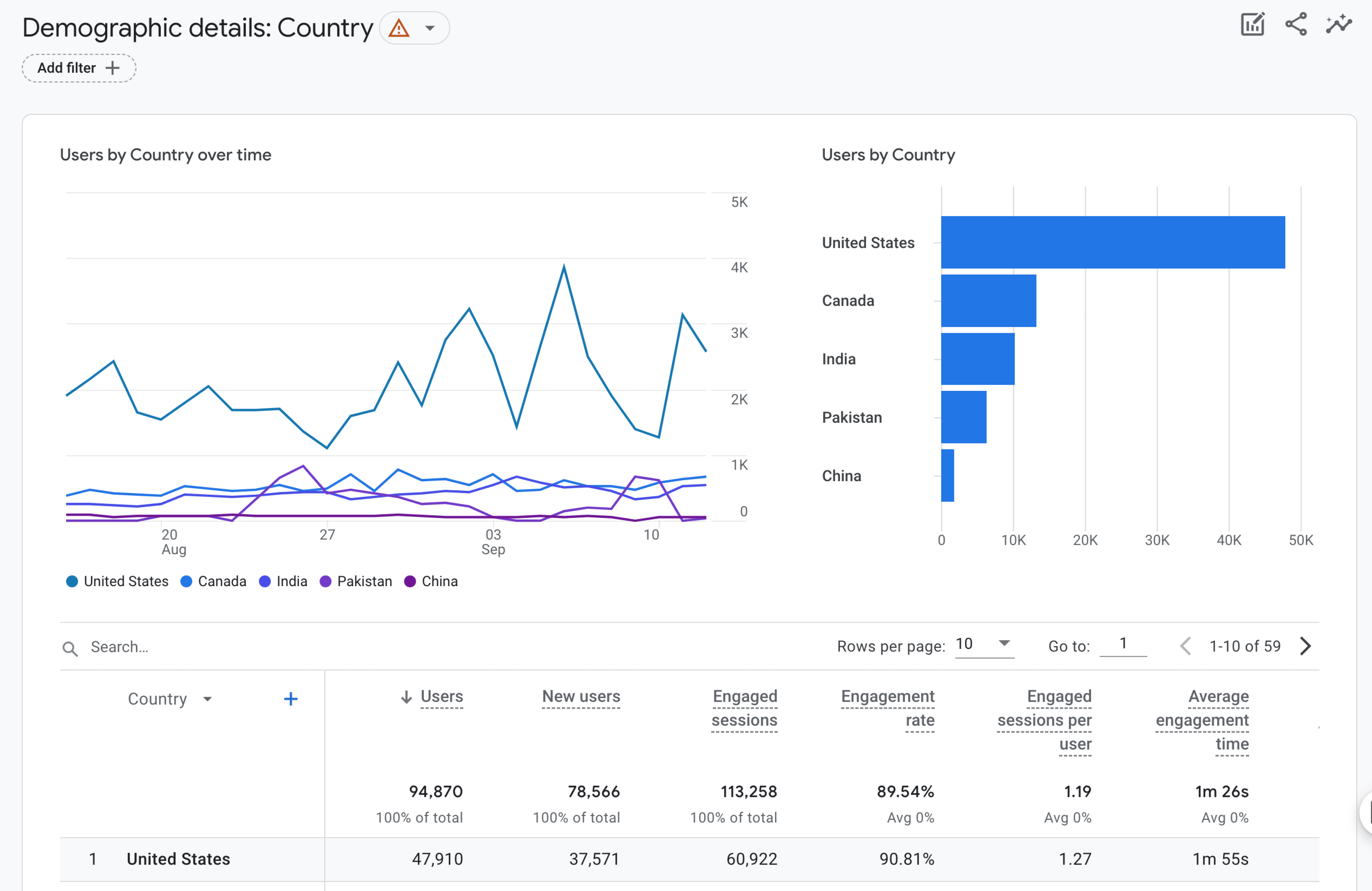
In the Audiences report, you can identify which audiences are the most engaged or profitable. It requires at least 1 user to be tracked in your chosen date range.
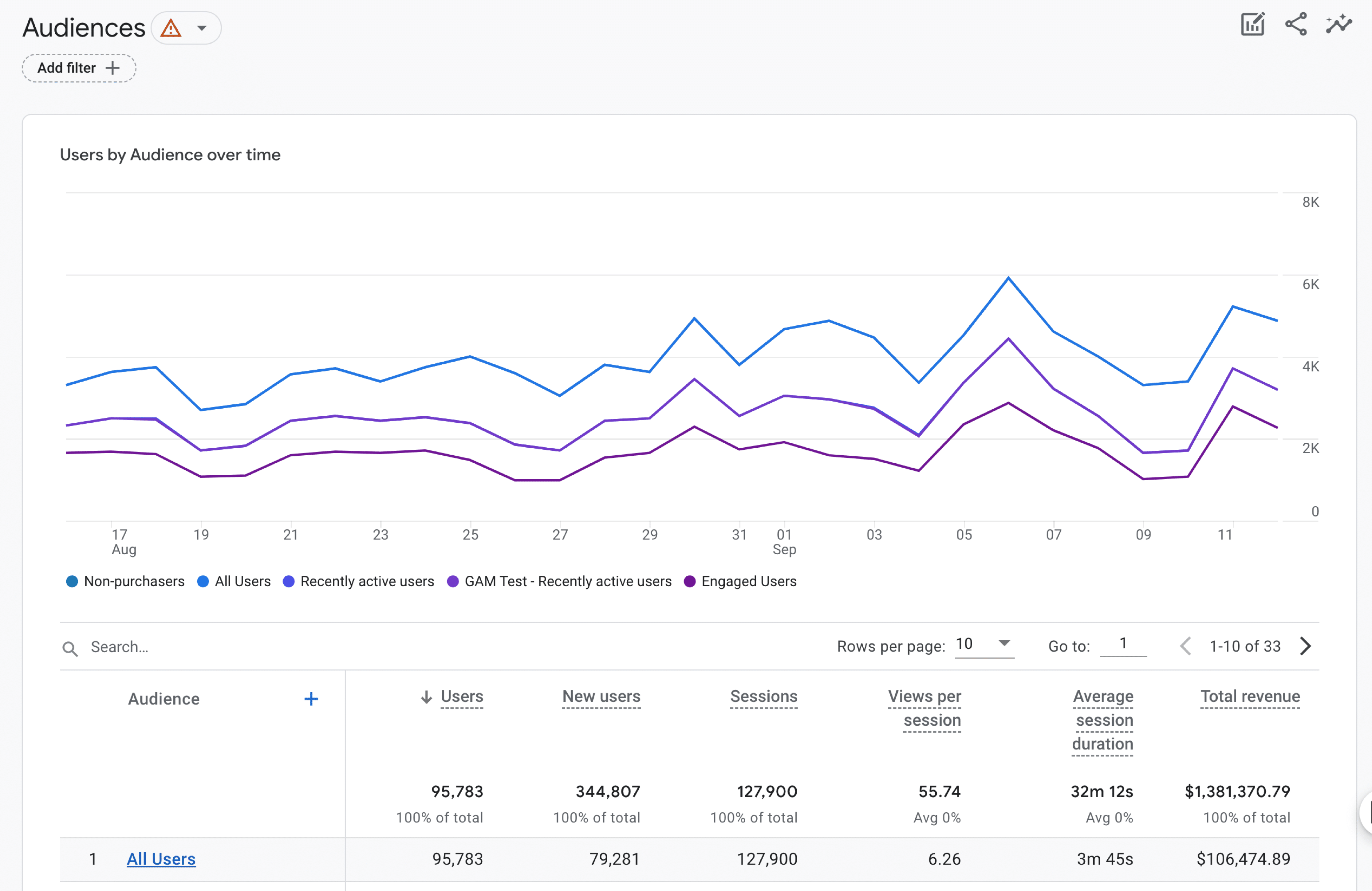
Within the Tech tab, the following reports are:
- Overview
- Tech details
In the Tech overview report, you will see a general overview of users’ activity organized in cards with data on platform, operating system, browser, device category, screen resolution, app version, and device model.
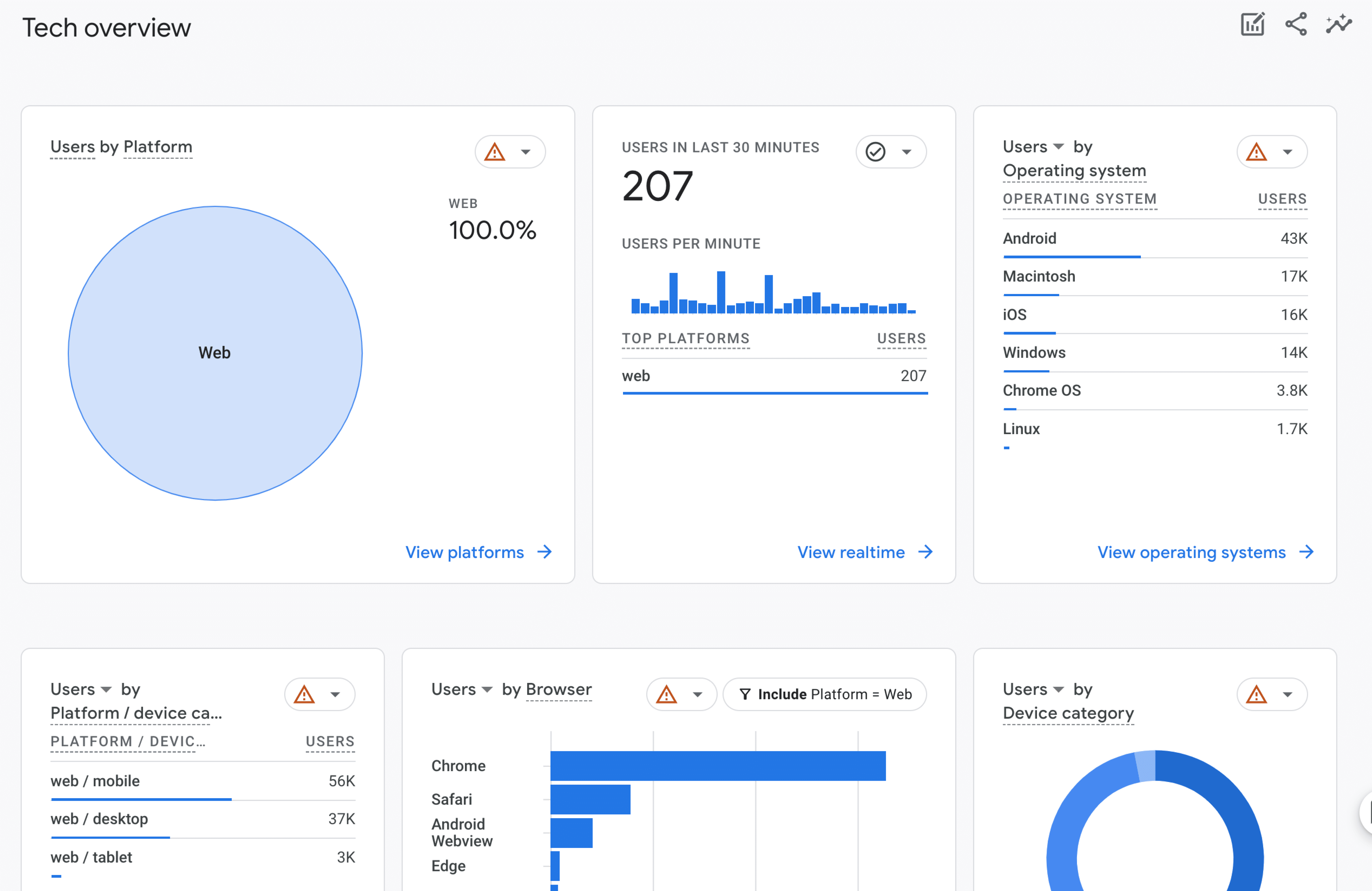
In the Tech details report, you will see a more detailed breakdown of your users’ technology use. By default, the report will load Browser data, but this can be swapped by clicking on the “Browser” parameter (under the “Search…” bar) and choosing other options available in the dropdown.
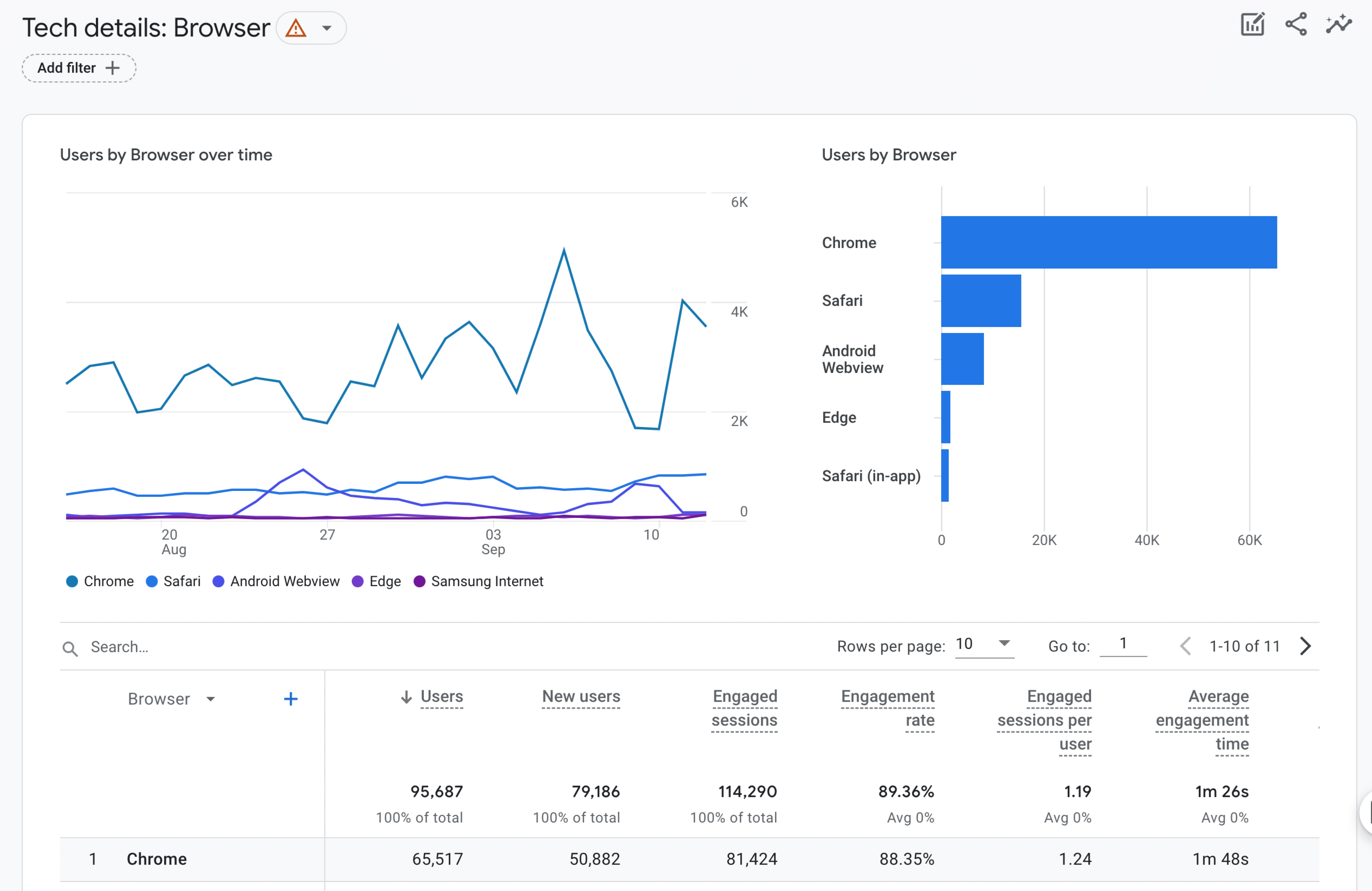
Introduction to Google Analytics Explore Reports
Exploration reports allow Google Analytics users to create custom reports using various dimensions and metrics as needed, not easily available in the standard reports provided. When creating a custom exploration, there are a number of templates to use:
- Blank
- Free form
- Funnel exploration
- Path exploration
- Segment overlap
- User explorer
- Cohort exploration
- User lifetime
As well as a link to view the Template Gallery for more. Each form can be used to visualize data in different ways and will require experimentation on which is best suited for your needs.
To set up a custom exploration, you will need to first import Dimensions and Metrics under the Variables column.
Once imported, you’ll then drag and drop a dimension into the Rows or Columns section, and drag and drop a metric into the Values section. Rows, Columns, and Values are found under the Tab Settings column.
Lastly, in a custom exploration, the Date Range stays set to whichever dates are selected and need to be updated if you wish to see more recent data.
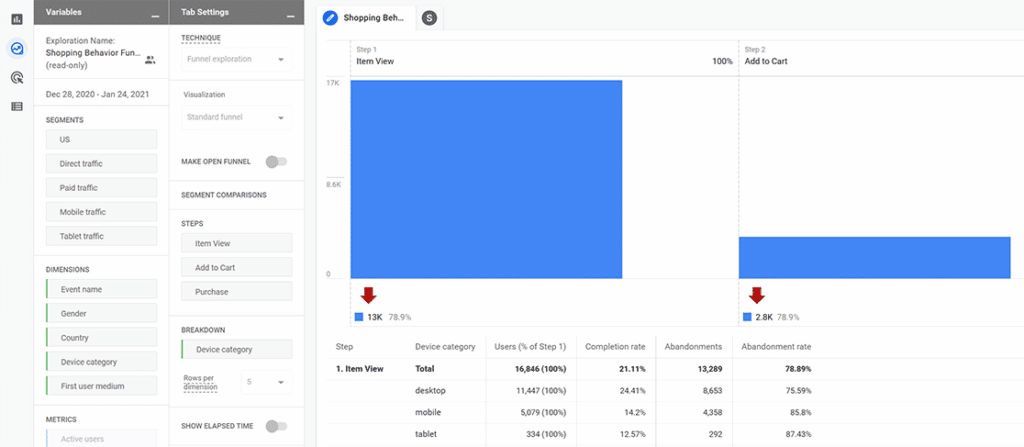
Introduction to Google Analytics Advertising
If you’ve connected your Google Analytics property to your Google Ads account, you will be able to view your Google Ads campaign data in the Advertising section.
Within the Advertising page, the following reports are
- All channels (Performance)
- Model comparison
- Conversion paths
In the All channels performance report, you will be able to see which channels and campaigns were attributed to conversions.
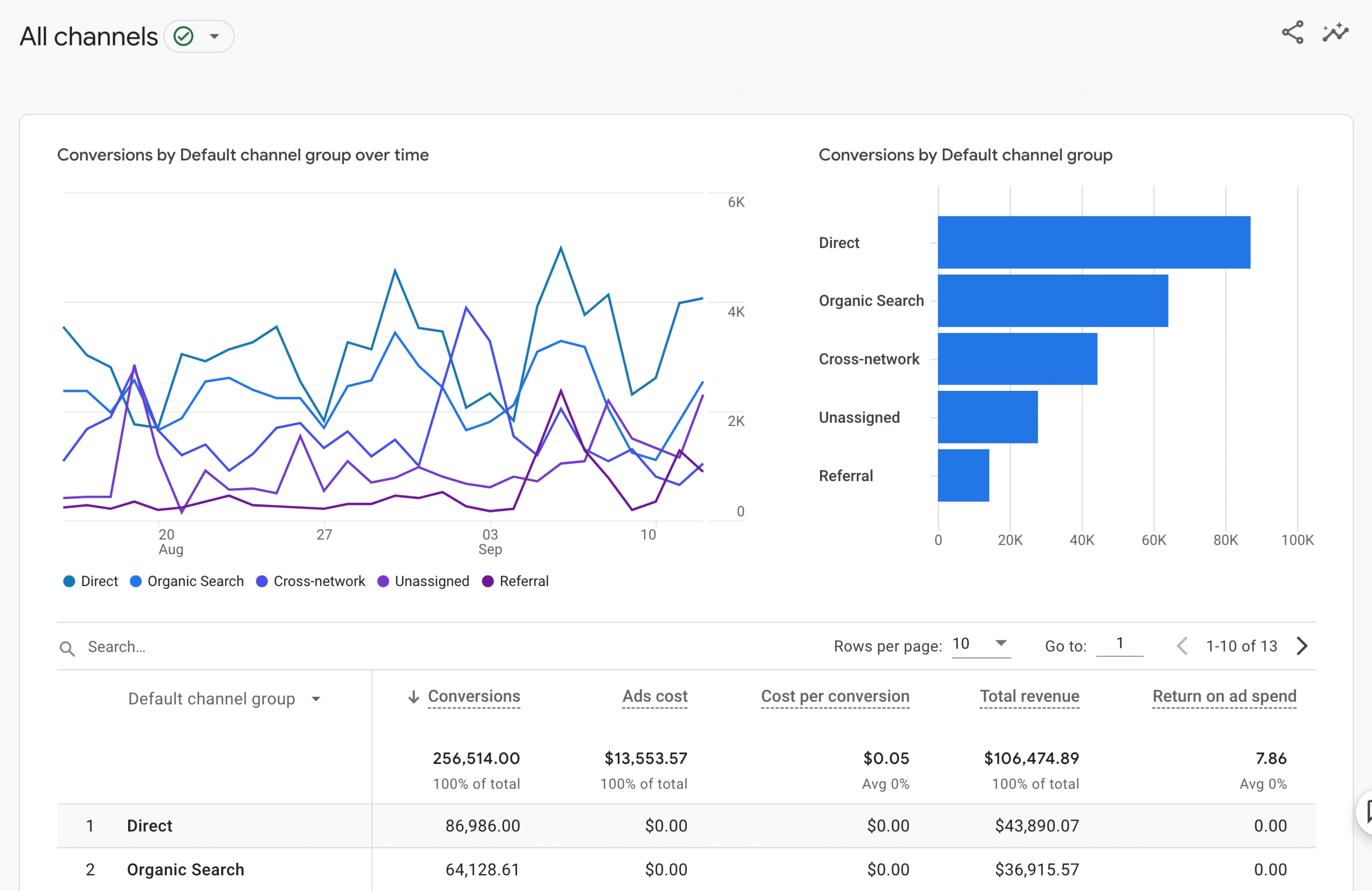
In the Model comparison report, you will be able to see how each attribution model is performing, depending on which one is selected. To learn more about attribution models, see Google’s guide: Select attribution settings.
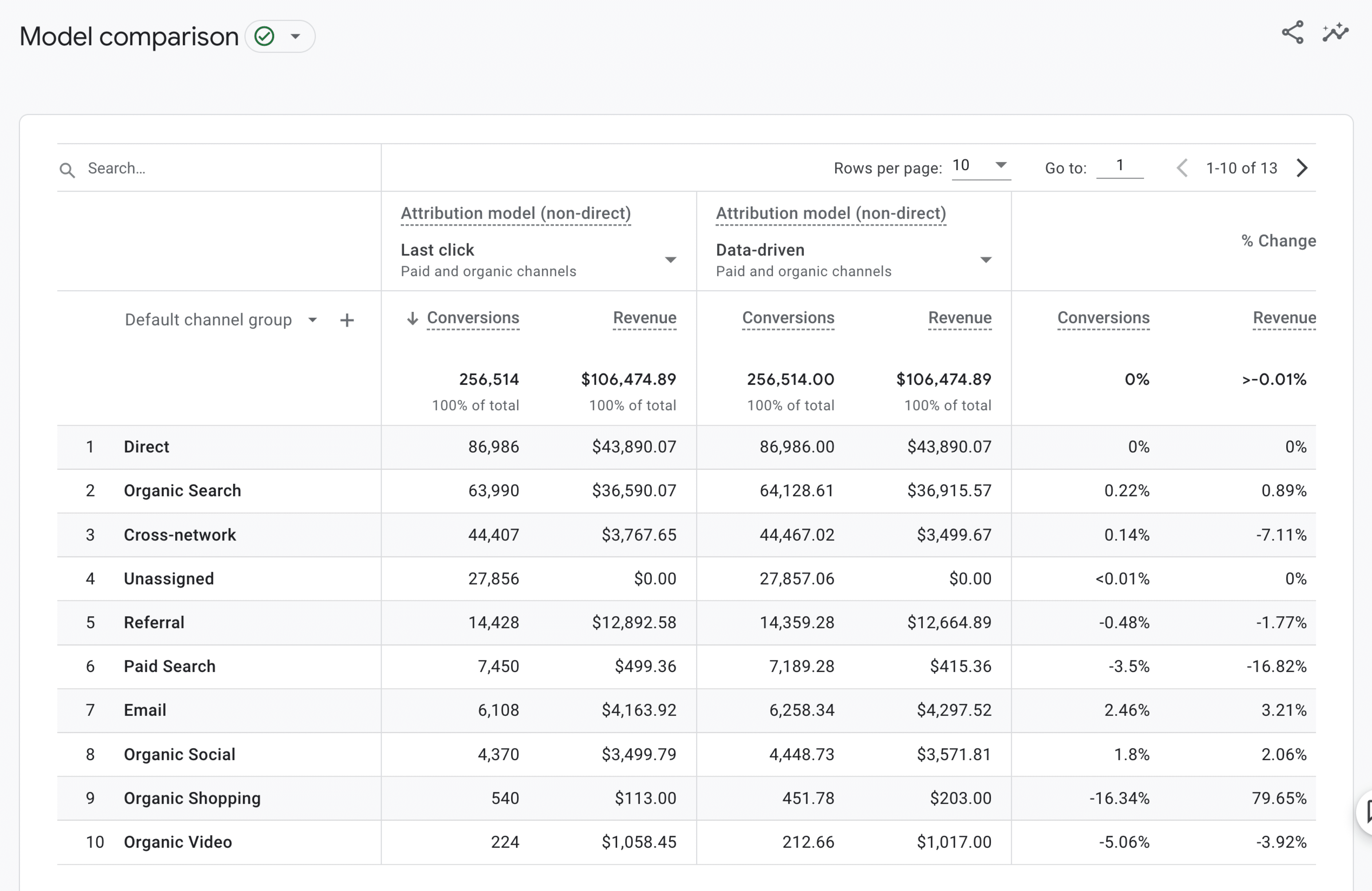
In the Conversion paths report, you will be able to see your conversion path performance.
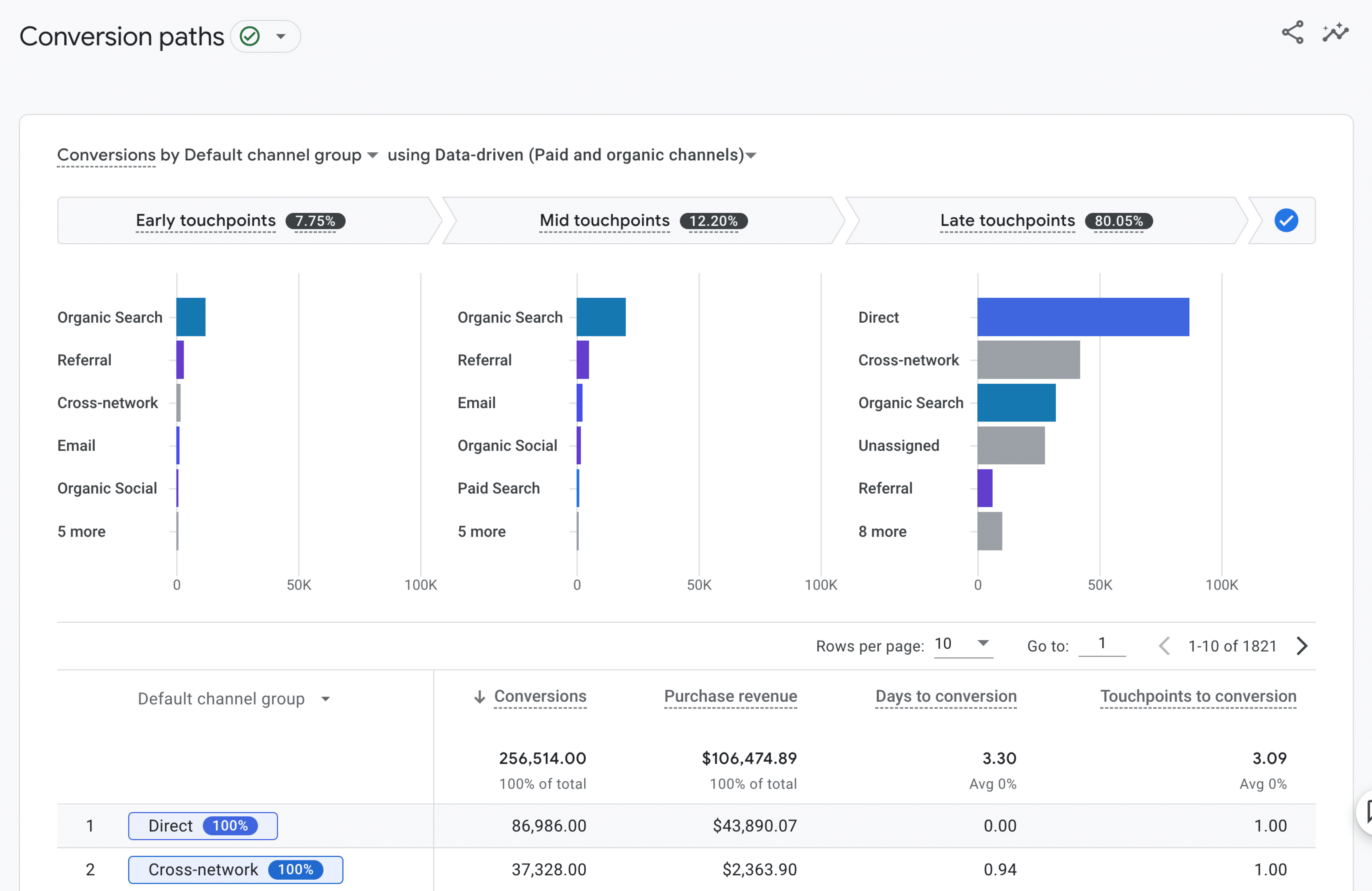
Manage your Google Analytics Events, Audiences or Custom definitions
Within the Admin, you’ll be able to add, edit, or manage the following:
- Events
- Conversions
- Audiences
- Custom definitions
- DebugView
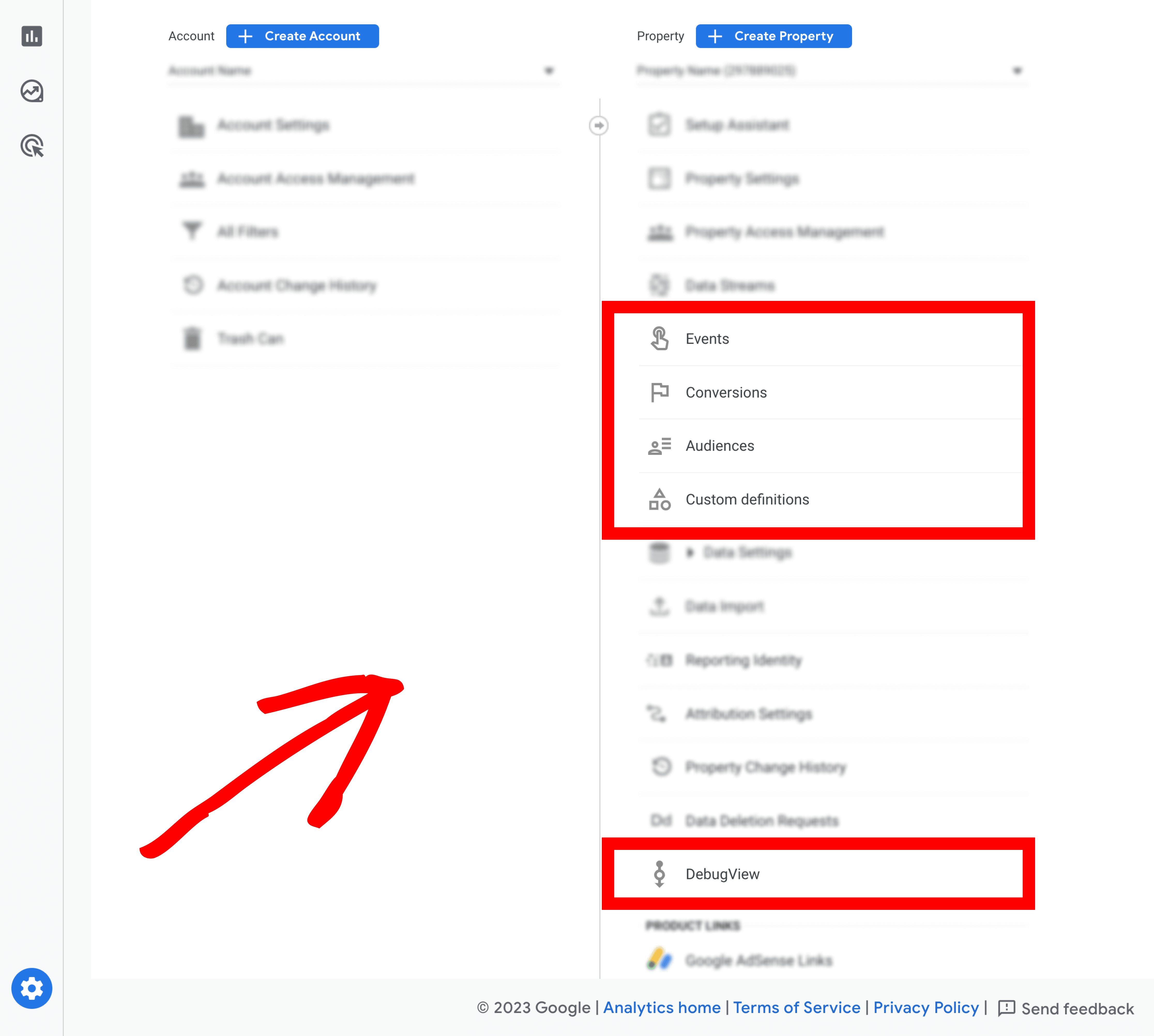
In the Events page, you’ll be able to see a list of events that are used for tracking in your Google Analytics property. With ExactMetrics, we automatically create and manage events for you.
If needed, using our existing events, you can create your own custom events without having to use any custom code snippets. For more information, please check out this guide: Custom events.
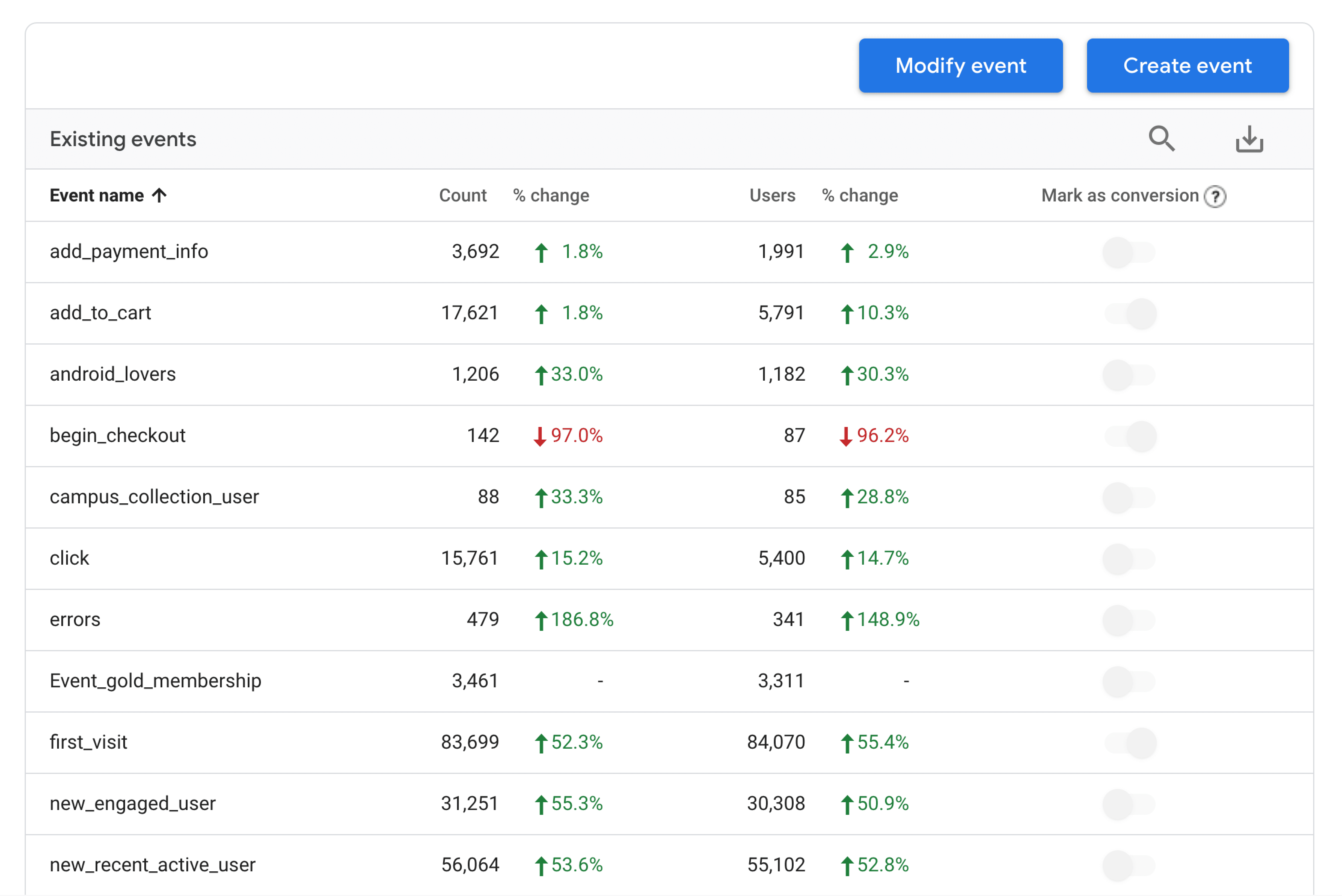
In the Conversions page, you’ll see a list of events that are being tracked as conversions. ExactMetrics will automatically create and setup eCommerce events for tracking, but you can also mark other events to be tracked as a conversion by enabling the marked as conversion toggle in the Events page.
Once enabled, the change will take place moving forward and will not affect historical data. It will take up to 24 hours to show in standard reports, but the change will appear sooner in the Realtime reports.

In the Audiences page, you’ll be able to see a list of audiences as well as create new ones to help segment your traffic using dimensions, metrics, or events.
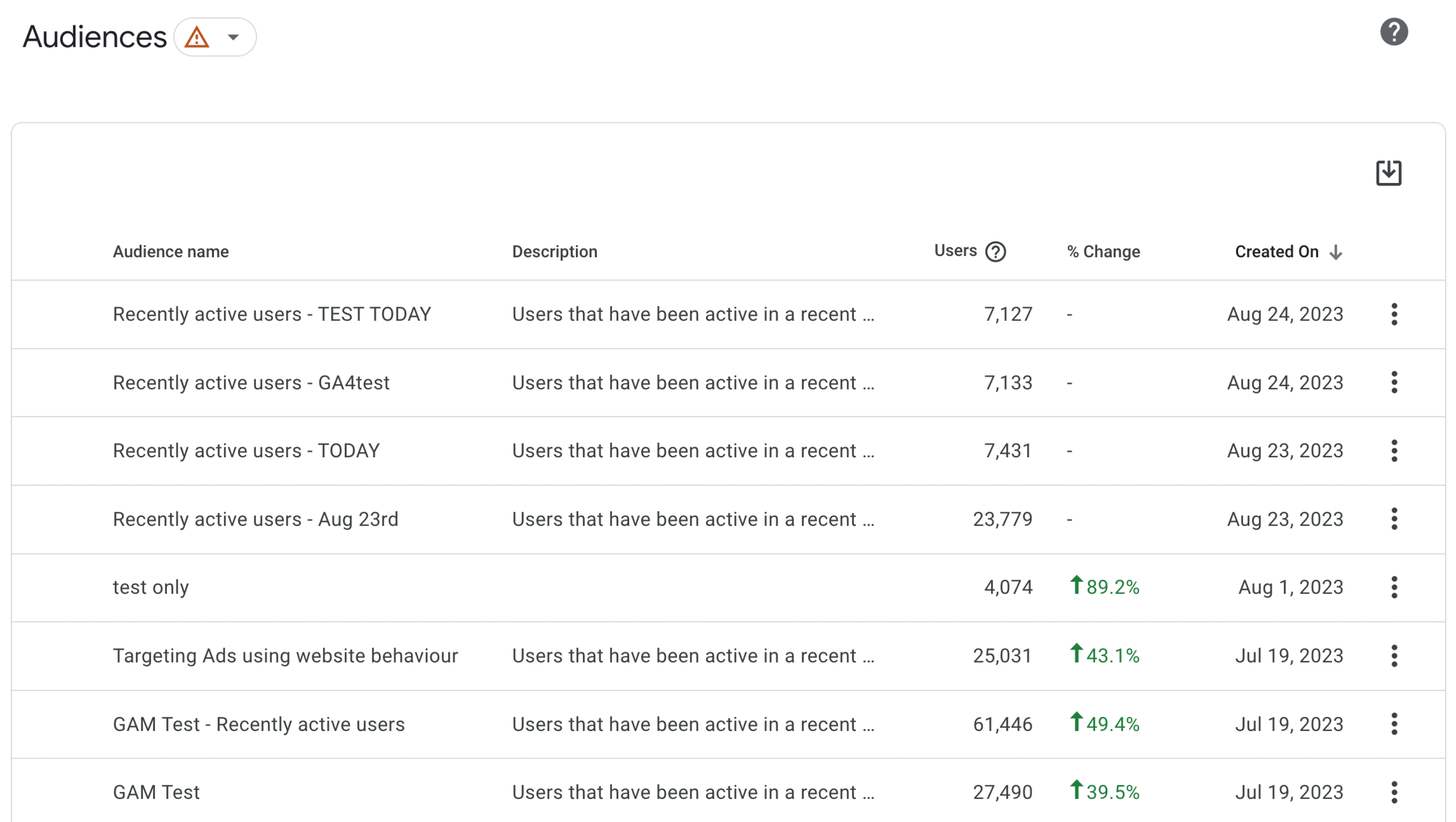
In the Custom definitions page, you’ll be able to see a list of all of your custom dimensions or custom metrics. When you connect ExactMetrics to your Google Analytics property, we automatically create all custom dimensions needed for tracking, and this is where you’ll be able to see them. The description will be “ExactMetrics custom dimension”.
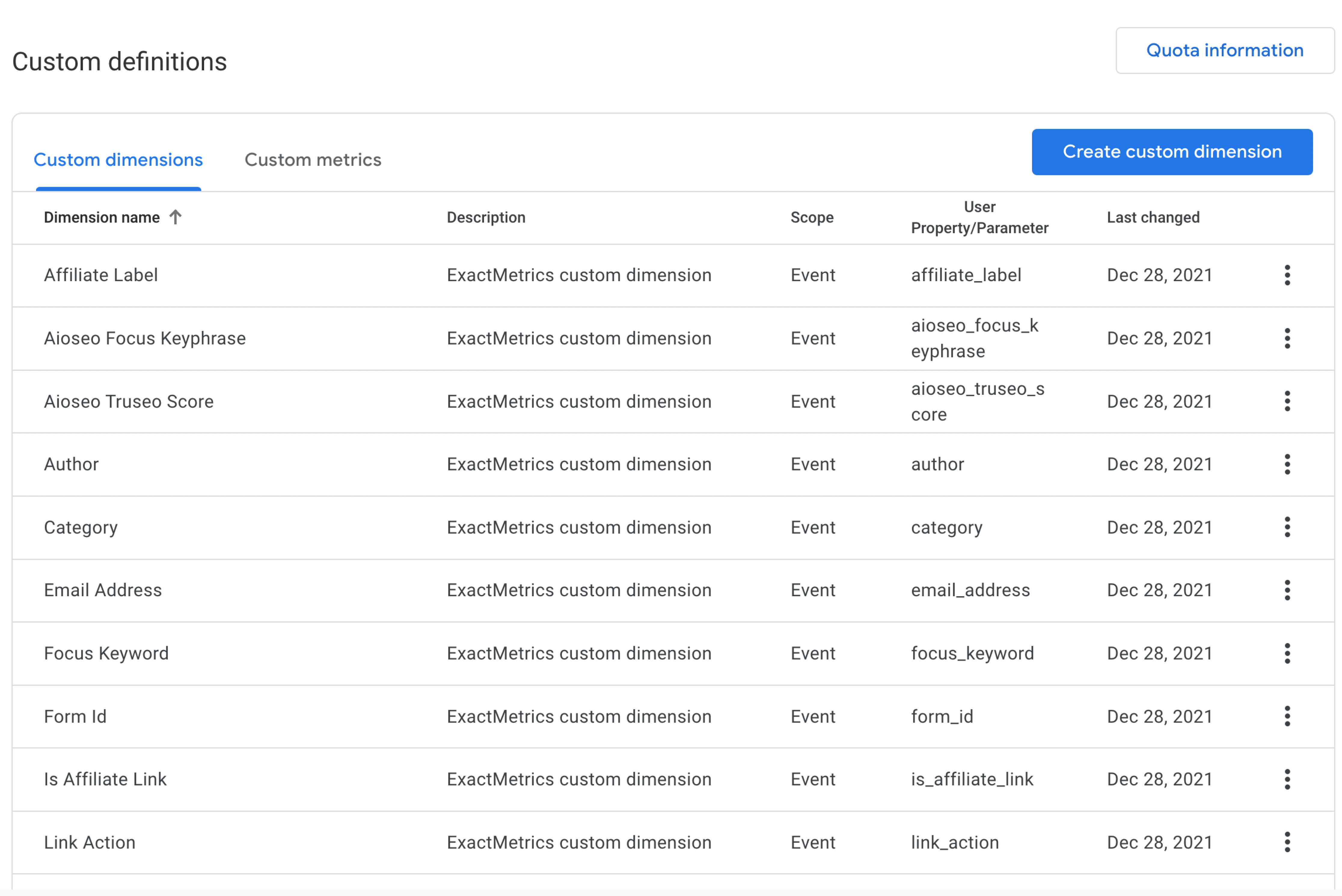
Lastly, in the DebugView page, you will be able to view data in real-time, which is useful for troubleshooting issues as they come up. To monitor events on this page, you’ll need to Enable debug mode first.
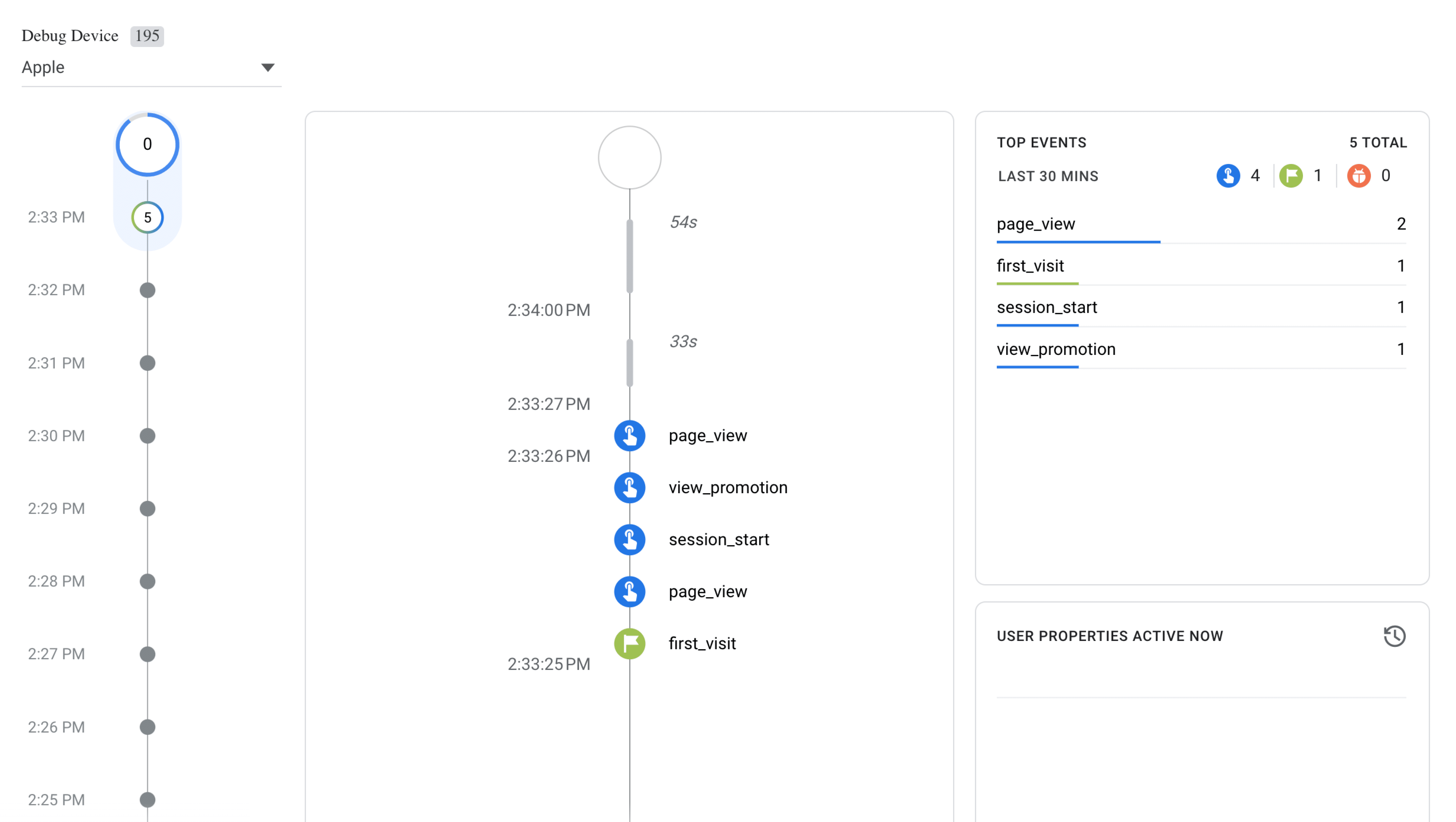
You did it! You learned a little bit more about what Google Analytics does and why it’s essential for websites.
What’s next? Take a look at our guide to setting up Affiliate Link Tracking, or eCommerce.

